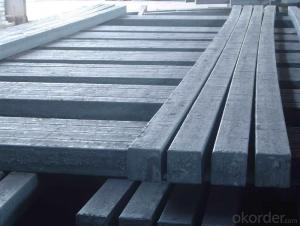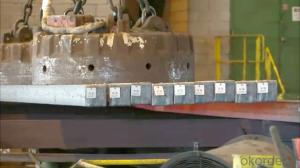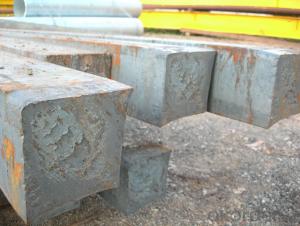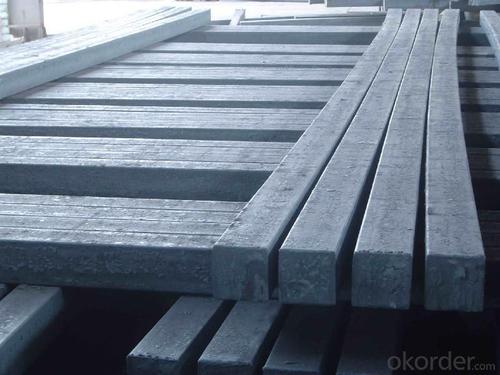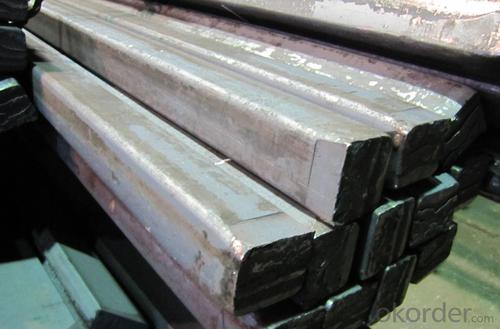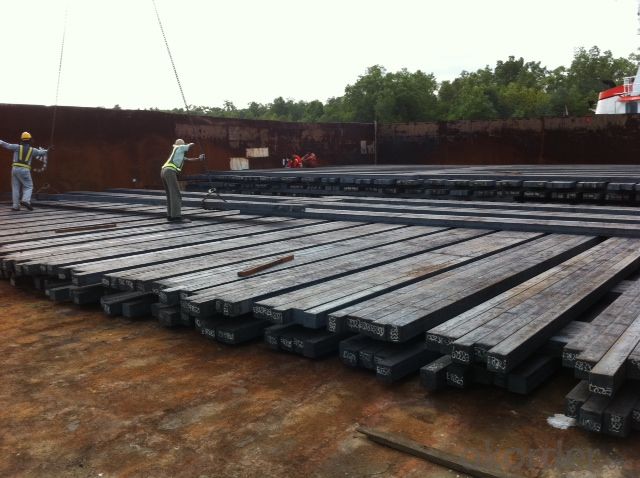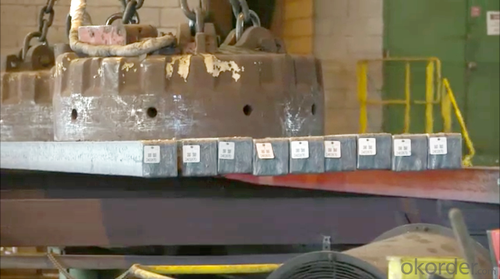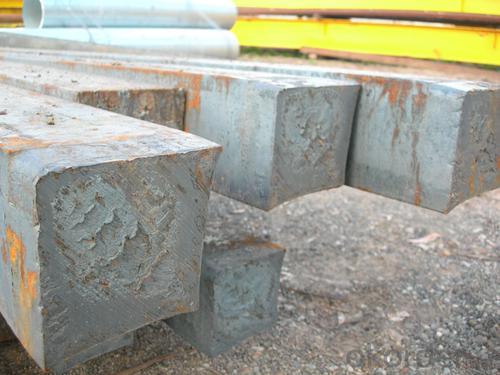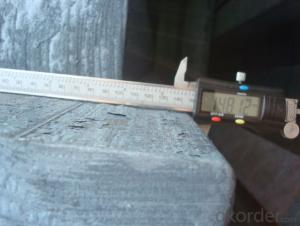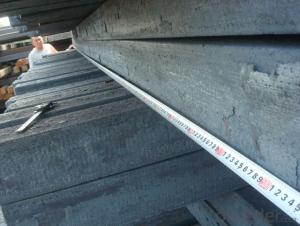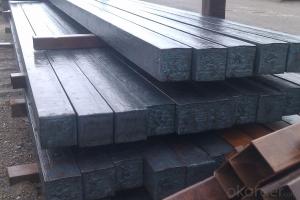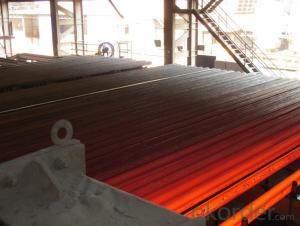Prime square alloy steel billet 155mm Q235
- Loading Port:
- Shanghai
- Payment Terms:
- TT OR LC
- Min Order Qty:
- 100 m.t.
- Supply Capability:
- 10000 m.t./month
OKorder Service Pledge
OKorder Financial Service
You Might Also Like
Structure of Prime square alloy steel billet 155mm Q235

Description of Prime square alloy steel billet 155mm Q235
1) Excellent corrosion resistance: The zinc layer provides a good protection of Pre-painted Galvanizeed Steel Sheet.
2) High heat resistance: The reflective surface of the material aids in efficiently reflecting the sunlight away and in turn reducing the amount of heat transmitted. The thermal reflectivity converts into energy savings.
3) Aesthetics: Pre-Painted Galvanized steel sheet is available in plethora of patterns and multiple sizes as per the requirements that given by our customers.
4) Versatility: can be used in the various areas.

Main Feature of Prime square alloy steel billet 155mm Q235
Uncoated CR steel sheet
With the features of in line with the international highest standards in demension and shape, excellent surface finish and properties, the products are mainly used in home appliance and automobile industries.
Galvanized steel sheet(include HDG and EG)
With the features of good corrosion resistance, the products are mainly used in automobile, home appliance, electronics, building and machinery manufacture industries, etc.
Precoated steel sheet
With the features of enviromental protection and good processablility, long lasting surface durability, rich in colors, the products are maily used in building, home appliance and furniture industries, etc.
Applications of Prime square alloy steel billet 155mm Q235
1) Excellent corrosion resistance: The zinc layer provides a good protection of Pre-painted Galvanizeed Steel Sheet.
2) High heat resistance: The reflective surface of the material aids in efficiently reflecting the sunlight away and in turn reducing the amount of heat transmitted. The thermal reflectivity converts into energy savings.
3) Aesthetics: Pre-Painted Galvanized steel sheet is available in plethora of patterns and multiple sizes as per the requirements that given by our customers.
4) Versatility: can be used in the various areas.

Specifications of Prime square alloy steel billet 155mm Q235
Product | Billet |
Material Grade | SGCC / SGCH / DX51D+AZ, etc |
Thickness | 0.6-3.0mm |
Width | 500-1500mm |
Tolerance | Thickness: +/-0.02mm , Width:+/-2mm |
Zinc-coating | Z30-150g/m2 |
Technique | Raw material: Hot rolled steel coil --> Cold rolled_>hot dipped galvalume |
Surface | Dried, Chromated, Unoiled |
Spangle | Regular spangle , small spangle, zero spangle |
ID | 508MM 610MM |
Coil weight | 1-25MT |
Export package | Cardboard inner sleeves, Waterproof paper, galvanized steel covered and steel strip packed |
FAQ of Prime square alloy steel billet 155mm Q235
We have organized several common questions for our clients,may help you sincerely:
1. How Can I Visit There?
Our company is located in Tianjin City, China, near Beijing. You can fly to Tianjin Airport Directly. All our clients, from home or aboard, are warmly welcome to visit us!
2. How Can I Get Some Sample?
We are honored to offer you sample.
3. Why choose CNBM?
we always fix steel produce in container well to make it safe arrive at destination port
we always provide best and professional forward service for our buyer
we always apply 14days free detention for our buyers container in destination
we provide one set After-sales service for our buyer
we provide China inland steel market price report
we help our buyer become number one in local market .
- Q: How do steel billets contribute to the overall cost-effectiveness of a structure?
- The overall cost-effectiveness of a structure is greatly enhanced by the use of steel billets in multiple ways. Firstly, the manufacturing process of steel billets is highly efficient, resulting in minimal wastage of raw materials. This efficiency significantly reduces the production cost of steel billets, making them a cost-effective option for construction projects. Furthermore, steel billets possess exceptional strength and durability, enabling them to withstand heavy loads and adverse weather conditions. This strength eliminates the need for frequent repairs or replacements, saving significant costs in the long term. Additionally, the durability of steel billets ensures the longevity of the structure, reducing maintenance expenses and enhancing cost-effectiveness. Another significant aspect of steel billets that contributes to cost-effectiveness is their versatility. They can be easily molded and shaped into various forms, allowing for customization and precise engineering in constructing the structure. This versatility eliminates the need for excessive material wastage and enables the optimization of resources, thereby reducing costs. Moreover, steel billets have excellent fire resistance properties, making them a safe and reliable choice for structures. By minimizing the risk of fire-related damages, steel billets contribute to reduced insurance costs for the structure, enhancing its overall cost-effectiveness. Lastly, steel billets are often produced using recycled steel, which not only reduces the environmental impact but also lowers the production cost. This eco-friendly aspect further enhances the cost-effectiveness of a structure by reducing the overall carbon footprint and making it more sustainable in the long term. In conclusion, the cost-effectiveness of a structure is improved through the use of steel billets by minimizing material wastage, providing strength and durability, offering versatility in design and engineering, ensuring fire resistance, and promoting sustainability. These factors collectively reduce production, maintenance, repair, and insurance costs, making steel billets a financially beneficial choice for construction projects.
- Q: What are the main alloying elements used in steel billet production?
- The main alloying elements used in steel billet production are carbon, manganese, silicon, and chromium.
- Q: How are steel billets used in the production of agricultural implements?
- Steel billets are used in the production of agricultural implements by being further processed and shaped into various components such as plowshares, tillage tools, and blades. These billets serve as the raw material from which these implements are manufactured, providing the necessary strength, durability, and resistance to withstand the demanding conditions of agricultural operations.
- Q: How do steel billets contribute to the manufacturing of industrial equipment?
- The production of industrial equipment heavily relies on steel billets, which are essential for the manufacturing process. These semi-finished steel products are created through casting and act as the raw material for a wide range of industrial equipment. A key aspect of steel billets is their versatility, which greatly contributes to the manufacturing of industrial equipment. They possess both malleability and strength, allowing them to be easily shaped and molded into various forms, such as bars, rods, or sheets. This adaptability enables manufacturers to produce durable and reliable components and structures capable of withstanding heavy loads and extreme conditions. Furthermore, steel billets offer an impressive strength-to-weight ratio, making them particularly suitable for applications where reducing weight is crucial without compromising structural integrity. This quality proves beneficial for industrial equipment that requires frequent transportation or movement, as the use of lightweight steel billets optimizes efficiency and minimizes energy consumption. Additionally, steel billets play a significant role in protecting industrial equipment against corrosion and wear. Many industrial environments expose equipment to harsh conditions, including moisture, chemicals, and abrasion. The utilization of steel billets ensures that the equipment remains resistant to these challenges, reducing maintenance and replacement costs while maintaining performance over time. Moreover, steel billets facilitate efficient heat treatment processes during the manufacturing of industrial equipment. Through controlled heating and cooling procedures, manufacturers can enhance the mechanical properties of the steel, such as hardness, toughness, and ductility. This enables the production of equipment capable of withstanding high temperatures, extreme pressures, and dynamic loading conditions, ensuring safety and reliability across various industrial applications. In conclusion, the role of steel billets in the manufacturing of industrial equipment is indispensable. Their versatility, strength-to-weight ratio, corrosion resistance, and facilitation of heat treatment processes contribute to the creation of durable, reliable, and high-performance equipment capable of meeting the demands of diverse industries.
- Q: How are steel billets used in the production of gear blanks?
- Steel billets are used in the production of gear blanks as they serve as the raw material for shaping and forming the gears. The steel billets are heated and forged into the desired shape, and then machined to create the gear blanks. These gear blanks are further processed and finished to become fully functional gears, which are then used in various machinery and equipment.
- Q: How are steel billets used in the manufacturing of industrial compressors?
- Steel billets are crucial in the manufacturing of industrial compressors as they serve as the raw material for forging or machining the various components of the compressors such as cylinders, pistons, and crankshafts. These billets are heated and shaped through different manufacturing processes to create the desired compressor parts, ensuring strength, durability, and high performance in the final product.
- Q: What are the different types of surface coating methods used for steel billets?
- Steel billets commonly undergo various surface coating methods to improve their durability, corrosion resistance, and overall performance. Some frequently utilized techniques for coating steel billets include: 1. Hot-dip galvanizing: Immersing the steel billets in molten zinc forms a protective layer, ensuring excellent durability and preventing corrosion. 2. Electroplating: Electrochemically depositing a thin layer of metals like zinc, nickel, or chromium onto the surface of the steel billets enhances corrosion resistance and improves aesthetics. 3. Powder coating: Applying a dry powder onto the steel billets' surface and subsequently heating it creates a protective layer. This method offers exceptional durability, chemical resistance, and a wide range of color options. 4. Paint coating: A liquid paint is applied to the steel billets, forming a protective layer that provides corrosion resistance. This technique allows for customization with different colors and finishes. 5. Thermal spray coating: A thermal spray gun is used to spray molten or powdered metals onto the steel billets' surface. This coating provides outstanding wear resistance, corrosion protection, and can be customized with various materials. 6. Anodizing: While primarily used for aluminum billets, anodizing can also be applied to steel. This electrochemical process creates an oxide layer on the steel billets' surface, enhancing corrosion resistance and providing a decorative finish. Each of these coating methods has its own set of advantages and disadvantages, and the selection depends on factors such as the desired protection level, aesthetics, and specific requirements of the steel billets.
- Q: What are the different types of steel billet rolling techniques?
- There are several different types of steel billet rolling techniques used in the manufacturing process. These techniques are employed to shape the steel into desired forms and dimensions. Some of the commonly used techniques include: 1. Hot rolling: This is the most widely used technique where the steel billet is heated to high temperatures and then passed through a series of rolling mills. The hot rolling process helps in reducing the thickness and increasing the length of the steel billet. 2. Cold rolling: In this technique, the steel billet is rolled at room temperature. It is used to produce steel with a smooth surface finish and precise dimensions. Cold rolling is often used for producing steel sheets, strips, and bars. 3. Ring rolling: This technique is used to produce seamless rings of steel. The steel billet is heated and then rolled between two rotating rolls, which gradually shape the billet into a ring. Ring rolling is commonly used in the production of bearings, gears, and flanges. 4. Continuous casting and rolling: This technique involves the continuous casting of molten steel into billets, which are then directly rolled into desired shapes. Continuous casting and rolling eliminate the need for separate casting and rolling processes, making it a more efficient and cost-effective technique. 5. Cross-rolling: Cross-rolling is used to produce steel billets with non-uniform cross-sections. The billet is rolled between two rolls that have different profiles, resulting in a billet with a desired shape. 6. Skew rolling: Skew rolling is a technique used to produce steel balls used in various industries, such as mining and cement production. The steel billet is rolled between two rotating rolls at an angle, which creates a helical motion and forms the ball shape. These are just a few examples of the different types of steel billet rolling techniques. Each technique has its own advantages and is used based on the desired final product and manufacturing requirements.
- Q: How are steel billets inspected for quality?
- Steel billets are typically inspected for quality using various non-destructive testing methods such as visual inspection, ultrasonic testing, magnetic particle inspection, and dye penetrant testing. These tests help identify any surface defects, cracks, or internal flaws in the billets, ensuring that they meet the required quality standards before further processing.
Send your message to us
Prime square alloy steel billet 155mm Q235
- Loading Port:
- Shanghai
- Payment Terms:
- TT OR LC
- Min Order Qty:
- 100 m.t.
- Supply Capability:
- 10000 m.t./month
OKorder Service Pledge
OKorder Financial Service
Similar products
Hot products
Hot Searches
Related keywords
